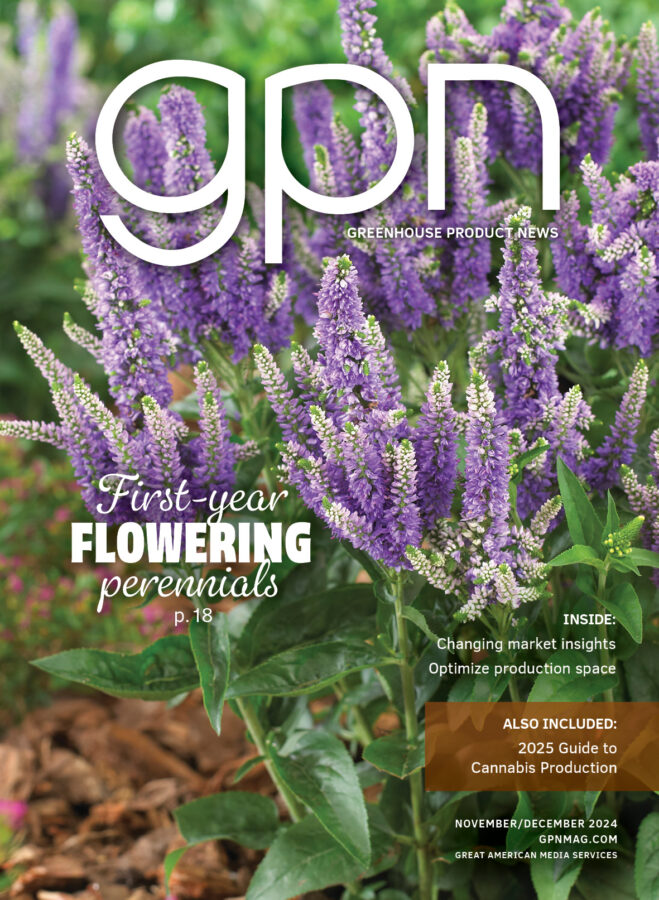Ornamental Pepper Production Tips
There are over 30 cultivars of ornamental peppers available.Many of the older cultivars like 'Filus Blue' or 'BolivianRainbow' are tall-growing and make excellent background plants in thelandscape. Plant breeders at the USDA in Beltsville, Md., have been workingwith ornamental peppers since 1991 and have released a number of new cultivars.This includes a number of compact cultivars that are excellent for container orborder plants. Some of the newer cultivars even have fruits that are not hot,like 'Medusa' from Pan American Seed Co. Floricultureinfo.comcontains additional information about 17 cultivars of ornamental peppers thatwere trialed at North Carolina State University. Some of the outstandingcultivars from the trials included: 'Jigsaw','Starburst', 'Masquerade', 'Pretty Purple','Treasures Red', 'Marbles' and Medusa.
Growing perfect peppers
Scheduling. Plants can be sold "green" 8-10 weeks aftersowing or when the peppers have colored after 15-20 weeks. Crop time is usually2-3 weeks shorter during summer production.
Seeding. Germination takes from 7-12 days at 70-75¡ F.Seeds can be sown in plug trays and transplanted into the final containerwithin 15-20 days after sowing. Avoid letting plugs become root-bound in theplug tray before transplanting, as restriction of root growth can stunt andstall the crop.
Containers. The most common container used for finishing is a 5-inchpot with one plant per pot. With all the possible variations in leaf color,fruit shape and growth habit, the uses of ornamental peppers are only limitedby your imagination. Larger containers also make a colorful display with threeplants per 6-inch pot or mum pan or a larger specimen plant in a patiocontainer. Some growers also produce 1801 cell packs for spring sales. Thisworks especially well for the purple or variegated foliage cultivars, çwhich consumers can easily differentiate from the peppers used in the vegetablegarden.
Root Substrate (Medium).
Irrigation. Ornamental peppers are not very forgiving of water stress,and repeated wilting can lead to lower leaf loss, fruit drop and a poor-qualitycrop. Drip or subirrigation should be used to prevent the foliage from stayingtoo wet, which can promote Botrytis. If hand-irrigating, consider morningirrigations to allow the foliage to dry during the day to avoid the occurrenceof Botrytis or root rot.
Nutrition. Ornamental peppers are moderate feeders. High levels ofphosphorus (P) and ammoniacal-nitrogen (NH4-N) (> 40 percent of total N)and/or urea in a fertilizer mix should be avoided to prevent excessive stemelongation. Ornamental peppers will become soft and leggy with excessivefertilizer.
Water quality will affect which fertilizers to use. If yourirrigation water is alkaline, use a 20-10-20 or similar acidic formulation toaid in pH management. If your irrigation water has low alkalinity, considerusing a 13-2-13 calcium-magnesium or similar basic formulation to aid in pHmanagement. Weekly rotation of an acid and basic fertilizer can be a usefultool to ensure proper pH balance for the crop.
Once the cotyledons protrude from the germination substrate,ç the first fertilization to the plug tray can be made. For the seedlingstage, fertilize at a rate of 50-75 ppm of nitrogen with a constant liquidfeed. Once plants are established, the recommended fertilization rates arebetween 150 and 200 ppm nitrogen (constant liquid feed).
Plants have a moderately high requirement for calcium andmagnesium. If these two elements are not supplied in irrigation water, thenthey need to be supplied through fertilization. The use of calcium nitrate orthe calcium-magnesium fertilizer formulas will provide adequate calcium. Tosupply magnesium, monthly applications of epsom salts (MgSO4á7H20)should be made at the rate of 1-2 lbs. per 100 gallons of water.
The root substrate pH and electrical conductivity (EC)should be monitored on a weekly basis because of the potential of saltaccumulation and/or the development of high or low pH values. The pH rangeshould be between 5.8 and 6.2. Low pH will cause the lower leaves to developdark purple spots. EC levels should be maintained between 0.5-1.0 mS/cm for the2:1 extraction method; 1.0-2.0 mS/cm for the saturated paste extraction method;or 1.5-2.8 mS/cm for the PourThru extraction method. Excessively high fertilityrates can be detrimental to fruit set.
Temperature. Once established, temperatures should be around 75¡ Fduring the day and 65¡ F at night. Avoid temperatures below 45¡ F, orchilling injury can occur. Temperatures above 85¡ F during fruit set (andmagnified if nutrient levels are excessive) can result in crop delay because offlower/fruit abscission.
Fine-tuning
Height Control and Pinching
There are a number of PGRs that are suitable for use onornamental peppers. Sumagic foliar sprays can be applied around 8-10 weeksafter sowing at the rate of 10-15 ppm for taller cultivars or 5-10 ppm formedium-sized cultivars.
Bonzi also controls the height of ornamental peppers.Research at NC State University found that a Bonzi foliar spray at 20 ppm wascomparable to Sumagic at 10 ppm on the Pretty Purple variety. Bonzi also hadthe advantage of not reducing the number of fruits on each plant, while the useof Sumagic resulted in a 36-percent decrease in fruit number.
B-Nine at 2,500 ppm can also be used for medium-sizedcultivars. Compact cultivars may not require any PGRs. The above rates weredetermined in the Southeastern United States for a crop maturing during latesummer. Rates should be adjusted for other locations and times of year.
Earlier research at the University of Georgia found thatFlorel at 150-300 ppm promotes earlier red and orange fruit coloration ofornamental peppers, although Florel is not registered for ornamental peppers.Our trials at NC State University found that foliar sprays of 150 ppm applied3-6 weeks after flowering hastened red fruit coloration by 2-3 weeks. Asufficient number of fruits must be near mature size prior to applying Florel.Florel applications will cause all flower buds and some of the small fruit todrop; rates higher than 300 ppm can even result in large fruit drop.
NOTE: PGRs can only be used on ornamental peppers notintended for consumption.
Pepper pests, pestilence and postproduction
Major Insect Pests. A number of insect pests can attack ornamentalpeppers. The major ones include aphids, spider mites and thrips. Aphids can becontrolled with foliar sprays of Endeavor, Horticultural Oil, InsecticidalSoap, Marathon, Orthene or Thiodan. Akari, Avid, Floramite, Hexygon, Floramite,Ovation, Pylon or Sanmite are all potential controls for spider mites. Thripswill feed on the immature leaves, causing leaf distortion, and the fruit, whichresults in a whitish appearance. Control thrips with Avid, Conserve or Mesurol.
Major Diseases. The most common diseases of ornamental peppers areBotrytis, impatiens necrotic spot virus (INSV) and Pythium. Botrytis, or graymold, commonly occurs during wet conditions accompanied by poor airflow. Drip,subirrigation or hand irrigation in the morning, along with good air movementwill help avoid this problem. Daconil Ultrex, Decree, Dithane or Kocide willhelp control Botrytis.
INSV appears as a dark, greasy stem lesion or a darkringspot on the leaves . The disease is spread by western flower thrips, andonce the plant is infected, it needs to be discarded. Western flower thripscontrol is required to control this disease.
Pythium root rot can occur if the soil is kept too moist.Managing the irrigations so that the substrate is not excessively wet will helpavoid problems. Possible controls for pythium include Aliette, Subdue Maxx andTerramaster.
NOTE: The pesticides listed above can only be used forornamental peppers not intended for consumption.
Post-Production Care. Temperatures can be decreased to 60-65¡ Fnights and 65-70¡ F days to help prolong fruit quality. Low-lightconditions can result in fruit drop, and exposure to ethylene during shippingshould be avoided.


 Video Library
Video Library 



















